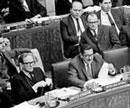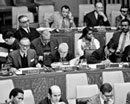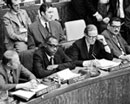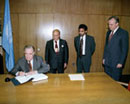|
Convention on the Law of the Non-Navigational Uses of International Watercourses
New York, 21 May 1997
By Stephen C. McCaffrey
Distinguished Professor at the McGeorge School of Law University of the Pacific
The 1997 United Nations Convention on the Law of the Non-Navigational Uses of International Watercourses is the only treaty governing shared freshwater resources that is of universal applicability. It is a framework convention, in the sense that it provides a framework of principles and rules that may be applied and adjusted to suit the characteristics of particular international watercourses. This introductory note will describe the historical background of the convention and significant developments in its negotiating history. It will then summarize the key provisions of the convention and, finally, touch upon its influence on subsequent legal developments, including both treaties and jurisprudence. The Convention was concluded on 21 May 1997, as an annex to General Assembly resolution 51/229. Its adoption brought to a close a process the General Assembly had initiated well over two decades earlier. On 8 December 1970, the General Assembly adopted resolution 2669 (XXV), entitled “Progressive Development and Codification of the Rules of International Law Relating to International Watercourses”. In that resolution, the Assembly recommended that the International Law Commission “take up the study of the law of the non-navigational uses of international watercourses with a view to its progressive development and codification.” In fact, the General Assembly had shown that it recognized the importance of this field over ten years earlier, when it adopted resolution 1401(XIV) on 21 November 1959. In that resolution, the Assembly had indicated that it was “desirable to initiate preliminary studies on the legal problems relating to the utilization and use of international rivers with a view to determining whether the subject is appropriate for codification”. The International Law Commission began work on the international watercourses topic in 1974 pursuant to the General Assembly’s 1970 resolution. Over the course of the next twenty years, the Commission’s work was guided by a succession of five special rapporteurs: Richard Kearney, Stephen Schwebel, Jens Evensen, Stephen McCaffrey, and Robert Rosenstock. Following its usual practice, the Commission in 1974 circulated a questionnaire to United Nations Member States seeking their views on various issues related to the watercourses topic. In 1976, the Commission decided that it was not necessary to determine the scope of the expression “international watercourse” at the outset of its work; in fact, the Commission did not define this expression until it adopted on first reading a full set of draft articles on the topic in 1991. The definition adopted in that year is substantially unchanged in the Convention. In 1994, the Commission concluded its work on international watercourses, adopting a complete set of 33 draft articles on second reading. The Commission also adopted a companion resolution on confined transboundary groundwater, which recommended that States be guided by the principles contained in the draft articles in regulating this form of groundwater. The Commission submitted its final draft and the resolution to the General Assembly with a recommendation that a convention be elaborated on the basis of the draft articles. On the recommendation of the Sixth (Legal) Committee, the General Assembly decided in 1994 to “convene a Working Group of the Whole . . . to elaborate a framework convention on the law of the non-navigational uses of international watercourses on the basis of the draft articles adopted by the International Law Commission.” The convention was negotiated in the Sixth Committee, convening for this purpose as a “Working Group of the Whole” as contemplated by the Assembly’s 1994 resolution. The Working Group met for three weeks in October of 1996 and two weeks in March and April of 1997. As already noted, the Convention was adopted on 21 May 1997. The Convention contains 37 articles arranged in seven parts: Part I. Introduction; Part II. General principles; Part III. Planned measures; Part IV. Protection, preservation and management; Part V. Harmful conditions and emergency situations; Part VI. Miscellaneous provisions; and Part VII. Final clauses. An annex to the Convention sets forth procedures to be followed in the event that States have agreed to submit a dispute to arbitration. While it is difficult to single out particular provisions of the Convention, based on the preparatory work in the International Law Commission, the negotiations in the Working Group and the significance of the principles involved, it may be said that the Convention’s key provisions are contained in Parts I, II, III and IV. Part I contains the definition of the expression “international watercourse,” which is obviously of central importance. Article 2 defines the term “watercourse” broadly as “a system of surface waters and groundwaters constituting by virtue of their physical relationship a unitary whole and normally flowing into a common terminus”. It will be noted that, importantly, this definition includes groundwater that is hydrologically connected with surface water, which is in fact the case for much of the world’s groundwater. The expression “international watercourse” is then defined as “a watercourse, parts of which are situated in different States”. Article 5, contained in Part II, reflects the principle that is widely regarded as the cornerstone of the Convention, and indeed the law in the field: equitable and reasonable utilization and participation. It requires that a State sharing an international watercourse with other States utilize the watercourse, in its territory, in a manner that is equitable and reasonable vis-à-vis the other States sharing it. In order to ensure that their utilization of an international watercourse is equitable and reasonable, States are to take into account all relevant factors and circumstances. An indicative list of factors and circumstances is contained in article 6. Article 5 also sets forth, in paragraph 2, the principle of equitable participation. According to this principle, States are to “participate in the use, development and protection of an international watercourse in an equitable and reasonable manner”. Thus, affirmative conduct may be required by this principle, which is a further elaboration of the implications of equitable and reasonable utilization. Another key provision of the Convention is article 7 (Obligation not to cause significant harm). This article requires that States “take all appropriate measures to prevent the causing of significant harm” to other States sharing an international watercourse. The emphasis on prevention is important, since it is often difficult to stop or modify an activity once it has begun, and it can be very complicated and expensive, if indeed it is possible, to remedy harm once caused. While there has been debate, both in the negotiation of the Convention and in the literature, about the relationship between the principles set forth in articles 5 and 7, the two are best seen as being complementary. The two articles work in tandem in the following way: if a State believes it has sustained significant harm due to a co-riparian State’s use of an international watercourse, it will ordinarily raise the issue with the second State. In the negotiations that follow, articles 5, 6 and 7 in effect provide that the objective is to reach a solution that is equitable and reasonable with regard to both States’ uses of the watercourse and the benefits they derive from it. The possibility that the solution may include the payment of compensation, to achieve an equitable balance of uses and benefits, is not excluded. Part III of the Convention sets forth the principle of prior notification of planned measures and elaborates in some detail on the various aspects of that obligation. The essence of the principle is that if a project or other measures are planned in a State and those measures may have a significant adverse effect upon another State or States sharing an international watercourse, the State in which the measures are planned must provide timely notification to the other States of the plans. If the notified States believe the planned measures would be inconsistent with the requirements of articles 5 or 7, a process of consultations and, if necessary, negotiations follows which is intended to lead to an equitable resolution of the situation. Part IV of the Convention deals with protection, preservation and management of international watercourses. It contains provisions on protection and preservation of watercourse ecosystems, prevention, reduction and control of pollution, and consultations concerning management of an international watercourse, among others. The importance of these provisions is perhaps obvious: watercourse ecosystems and watercourses themselves must be protected, preserved, and properly managed, if they are to support human and other forms of life. The Convention and its preparatory work have had significant influence. Four months after it was concluded, the International Court of Justice referred to and quoted from the Convention in its judgment in the Gabčíkovo-Nagymaros Project case (I.C.J. Reports 1997, paragraph 85). In part because of its provenance, the Convention is widely viewed as a codification of customary international law with respect to at least three of the obligations it embodies, namely equitable and reasonable utilization, prevention of significant harm, and prior notification of planned measures. These and other provisions of the Convention have influenced the negotiation of treaties concerning international watercourses, as can readily be seen from even a cursory review of recent agreements, for example, the Revised Protocol on Shared Watercourses of the Southern African Development Community (SADC) of 7 August 2000. The 1997 United Nations Convention on the Law of the Non-Navigational Uses of International Watercourses represents an important contribution to the strengthening of the rule of law in this increasingly critical field of international relations and to the protection and preservation of international watercourses. In an era of increasing water scarcity, it is to be hoped that the Convention’s influence will continue to grow. This Introductory Note was written in June 2008.
The General Assembly, by resolution 2669 (XXV) of 8 December 1970, recommended that the International Law Commission should take up the study of the law of the non-navigational uses of international watercourses with a view to its progressive development and codification and, in the light of its scheduled programme of work, should consider the practicability of taking the necessary action as soon as the Commission deemed it appropriate. At its twenty-third session, in 1971, the Commission included the subject of non-navigational uses of international watercourses in its programme of work. The General Assembly, by resolution 2780 (XXVI) of 3 December 1971, recommended that the Commission should decide upon the priority to be given to the topic. At its twenty-fourth session, in 1972, the Commission indicated its intention to take up the Assembly’s recommendation when it came to discuss its long-term programme of work.
The same year, the Commission, pursuant to a recommendation contained in General Assembly resolution 3071 (XXVIII) of 30 November 1973, set up a Subcommittee to consider this topic. The Subcommittee submitted a report to the Commission (A/CN.4/283) that dealt with the nature of international watercourses and pointed out that preliminary questions to be examined were: the scope of the term “international watercourses” and the type of activities to be included within the term “non-navigational uses”. At the same session, the Commission adopted the report without change. The General Assembly, by resolution 3315 (XXIX) of 14 December 1974, recommended that the Commission should continue its study of the law of the non-navigational uses of international watercourses taking into account, inter alia, comments received from Member States on the questions mentioned in the Subcommittee’s report. The Commission proceeded with its work on the topic at its twenty-eighth, thirty-first and thirty-second sessions, from its thirty-fifth to forty-third sessions and at its forty-fifth and forty-sixth sessions, in 1976, 1979 and 1980, from 1983 to 1991 and in 1993 and 1994, respectively. The Commission appointed Richard D. Kearney, Stephen M. Schwebel, Jens Evensen, Stephen McCaffrey, and Robert Rosenstock as the successive Special Rapporteurs for the topic at its twenty-sixth, twenty-ninth, thirty-fourth, thirty-seventh and forty-fourth sessions, in 1974, 1977, 1982, 1985 and 1992, respectively. In its consideration of the topic, the Commission had before it the reports of the Special Rapporteurs, information provided by Governments as well as documents prepared by the Secretariat. At its thirty-second session, in 1980, the Commission began the first reading of the draft articles. At its forty-third session, held from 29 April to 19 July 1991, the Commission adopted on first reading the draft articles as a whole (A/CN.4/L.458 and Corr.1 and Add.1). In accordance with articles 16 and 21 of its Statute, the Commission decided to transmit the draft articles, through the Secretary-General, to Governments of Member States for comments and observations. The General Assembly, in resolution 46/54 of 9 December 1991, expressed its appreciation to the Commission for the completion of the first reading of the draft articles on the topic and urged Governments to present their comments and observations on the draft in writing, as requested by the Commission. At its forty-fifth session, in 1993, and forty-sixth session, in 1994, the Commission proceeded with its second reading of the draft articles on the basis of the reports submitted by the new Special Rapporteur for the topic, Mr. Rosenstock. At its forty-sixth session, in 1994, having considered the second report of the Special Rapporteur, the Commission decided to refer the entire set of the draft articles to the Drafting Committee. At the same session, on 24 June 1994, the Commission adopted the final text of a set of thirty-three draft articles on the law of the non-navigational uses of international watercourses, with commentaries, and a resolution on confined transboundary groundwater. In accordance with article 23 of its Statute, the Commission submitted the draft articles and the resolution to the General Assembly, together with a recommendation that a convention on the subject be elaborated by the Assembly or by an international conference of plenipotentiaries on the basis of the draft articles. The General Assembly, by its resolution 49/52 of 9 December 1994, invited States to submit written comments and observations on the draft articles adopted by the Commission, and decided that, at its fifty-first session, in 1996, the Sixth Committee would convene as a Working Group of the Whole, open to States Members of the United Nations or members of specialized agencies, to elaborate a framework convention on the law of the non-navigational uses of international watercourses on the basis of the draft articles adopted by the Commission in the light of the written comments and observations of States and views expressed in the debate at the forty-ninth session of the General Assembly. The Working Group of the Whole of the Sixth Committee held two sessions, from 7 to 25 October 1996 and from 24 March to 4 April 1997, the second having been held pursuant to General Assembly resolution 51/206 of 17 December 1996. The Working Group of the Whole established a Drafting Committee. As mandated by General Assembly resolution 51/206, upon completion of its mandate, the Working Group reported directly to the General Assembly in its reports A/51/624 of 3 December 1996 and A/51/869 of 11 April 1997. By its resolution 51/229 of 21 May 1997, the General Assembly, upon recommendation of the Working Group of the Whole, adopted the Convention on the Law of the Non-navigational Uses of International Watercourses. The Convention was open for signature by all States and by regional economic integration organizations until 20 May 2000 at United Nations Headquarters in New York. Under article 36, paragraph 1, it shall enter into force on the ninetieth day following the date of deposit of the thirty-fifth instrument of ratification, acceptance, approval or accession. Text of the Convention Selected preparatory documents General Assembly, Verbatim records of plenary meeting No. 1920 of 8 December 1970 (A/PV.1920) The Convention entered into force on 17 August 2014. For the current participation status of the Convention, as well as information and relevant texts of related treaty actions, such as reservations, declarations, objections, denunciations and notifications, see:
|
|||||||||||||||||||||||||||||||||||||||||||||||||||||||||||||||||||||||||||||||||||||||||||

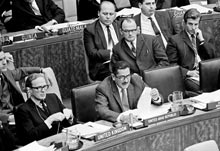 In 1974, the Secretary-General issued a supplementary report on the legal problems relating to the non-navigational uses of international watercourses (A/CN.4/274).
In 1974, the Secretary-General issued a supplementary report on the legal problems relating to the non-navigational uses of international watercourses (A/CN.4/274). 
